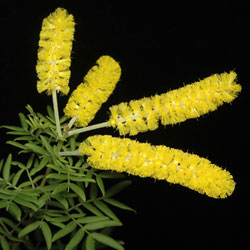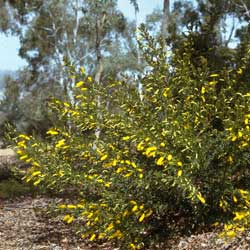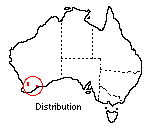Acacia drummondii
 |
 |
Drummond's Wattle
Drummond's Wattle (Acacia drummondii) grows wild among the undershrubs
in the forests of south-west Australia and is one of many Western Australian
plants which will grow in Canberra, given a little care. Though not new in cultivation
it is one of the lesser known wattles; a beautiful, delicate shrub useful where
space is limited in the garden. 
lt is tender to frost, wind and summer sun, all of which have caused losses in exposed positions. For the first few winters it must be protected from frost with a covering such as hessian. This should be thrown over nightly, supported on three stakes in the ground and not touching the plant. Shrubs when about 75 cm high may not need covering as only tip growth will be killed.
Taller shrubs, trees or rocks give excellent shelter where plants can develop to perfection. If away from other plants the form is upright and either compact or slightly arching, with a number of thin reddish main branches from ground level. lt reaches 1 .8 m high and the same in width.
Variations in form are known, including a prostrate one which could make a useful ground cover. If crowded among other plants this dwarf wattle spreads forward gracefully, and would adapt to a sloping wall or large rockery. It may also be grown in tubs and in mild districts as a hedge, lightly trimmed.
The foliage is ornamental and neat, midgreen or slightly bluish. Close inspection shows much divided though not feathery leaves, about 2.5 cm long, and facing upwards along the stems. Flower buds for next spring may be seen forming in summer along the entire length of the stems, each spike held well out on a stalk, one to each axil. From late September to early November flowers open rather unevenly, becoming profuse in October. The spikes are from 2 cm to 4 cm long, outstanding in quality and softness of appearance. They are a clear canary yellow, and scentless.
The species usually sets some seed in Canberra and this should be harvested when the pods are hard and brown. The germination rate can be improved if the hard seed coat is first softened with boiling water or scratched slightly before sowing with a file or sandpaper to admit water. Seedlings are susceptible to damping off and over-watering should be avoided.
Acacia drummondii has been grown from cuttings, but without special facilities this is not easy. Young plants may be obtained from most nurseries dealing in native plants. Most soils with good drainage are suitable, including local and clay soils. The plant's position is most important. Growth is rapid and light pruning after flowering helps to maintain bushy and long-lived specimens. This is not a good wattle for cut flowers, but presses beautifully.
Based on text by Irene Beeton (1971)
Name meaning: Acacia drummondiiAcacia - generally believed to be from a Greek word meaning to sharpen, alluding to the prickliness of the first species discovered; another opinion refers to the 'Egyptian Thorn' (akakia) a species of Acacia yielding gum-arabic; drummondii - after J. Drummond, first Government botanist of Western Australia |
![An Australian Government Initiative [logo]](/images/austgovt_brown_90px.gif)

